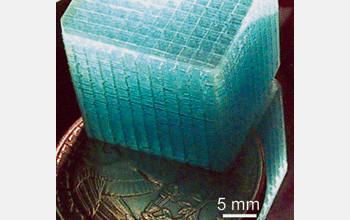Multimedia Gallery
Self-healing Materials With Microvascular Networks (Image 4)
Optical image of a 104-layer microvascular network enclosed in a clear epoxy matrix, with quarter-dollar coin for scale.
In nature, damage to an organism elicits a healing response. A research team led by Scott White, group leader for the Autonomous Materials Systems group at the Beckman Institute for Advanced Science and Technology at the University of Illinois at Urbana-Champaign, decided to apply this concept to synthetic material design and developed a self-healing polymer. Tiny capsules containing a healing agent were embedded in the polymer. When the material is damaged, the capsule ruptures and releases the healing agent, which repairs cracks. Further information about this new generation of bio-inspired healing materials is available Here. [Adapted from Therriault et. Al., Advanced Materials, Vol. 17, 2005.] (Date of Image: 2003) [Image 4 of 5 related images. See Image 5.]
Credit: Daniel Therriault, University of Illinois, 2003; Support: Air Force Office of Scientific Research
Images and other media in the National Science Foundation Multimedia Gallery are available for use in print and electronic material by NSF employees, members of the media, university staff, teachers and the general public. All media in the gallery are intended for personal, educational and nonprofit/non-commercial use only.
Images credited to the National Science Foundation, a federal agency, are in the public domain. The images were created by employees of the United States Government as part of their official duties or prepared by contractors as "works for hire" for NSF. You may freely use NSF-credited images and, at your discretion, credit NSF with a "Courtesy: National Science Foundation" notation.
Additional information about general usage can be found in Conditions.
Also Available:
Download the high-resolution JPG version of the image. (175 KB)
Use your mouse to right-click (Mac users may need to Ctrl-click) the link above and choose the option that will save the file or target to your computer.



